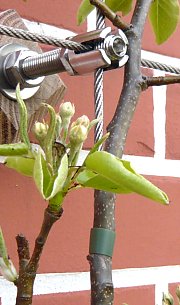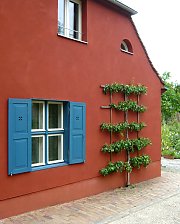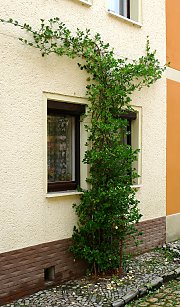Growth Habit: Shapeable Trees and Shrubs (Espaliers)
Trees and shrubs can be formed into specific shapes. We treat these shaped plants as their own growth type, even if it is an artificial one that would not occur this way in nature. Espaliered trees are brought from a "3D" to a "2D" shape by pruning and tying them in specific ways. Almost all perennial and woody climbing plants ("climbing shrubs"), as well as all fruit trees, can be more or less trained to specific geometric forms on the ropes or bars of a trellis framework. The tying and pruning techniques are different for every species.
Species
Fruit trees are especially compatible with facade greening, as they will benefit from the warmth of the facade microclimate and bear sweeter and earlier fruits that they would otherwise. Grapevines also have a tradition in Europe as espaliered and formed plants, as do firethorn, winter creeper, and cotoneaster. In facade greening, these are mainly considered 'shape-able / espalier plants.'
Trellis and Espalier Frameworks in General
The trellis frameworks for an espaliered tree (made of wire rope, metal rods, or wooden lattices) are usually constructed in such a way that the shaping of the plant takes place along the lines of the trellis, but the supporting trellis elements can also be placed diagonally or horizontally in relation to the trunk and branches. Selected young shoots are then fixed to the outside of the climbing aid with binding material or sometimes also put behind the ropes / rods.
Suitable trellises can consist either of only vertical lines, only horizontal lines, or can have a grid shape with one 'dominating' direction (meaning that in one direction the lattices will be further apart than in the other direction, as in a classic lattice fence where the vertical laths are close and the horizontal laths far apart). The dominant axes should be spaced 20 - 50 cm apart, depending on the plant type and its needs. A spacing of 1 to 2 m between the slats is sufficient if the trellis (lattice form) includes horizontal axes.
Suitable Wire Rope Trellis Systems
The growing trunk and branches will apply a strong lateral pressure on the trellis, along with the weight of leaves and fruit. This is relevant especially for wire rope trellises and they must be designed and planned accordingly. Especially with trees that are not planted in their final shape but are trained on the facade, it is important that the main branches and trunk align with the anchor points (and not between two brackets) of the trellis, so that weight and pressure are optimally distributed. The wire rope systems with square grids should be modified so that one axis is more dominant (see above). You will find information on appropriate trellis construction styles for each individual plant in the respective pages dedicated to climbing plants.
Sometimes Suitable Wire Rope Trellises
Wire rope trellises which have meshes that are too close or too far apart, or are too tall or too low for the plant, are not ideal and are only suitable in certain conditions.
Unsuitable Wire Rope Trellis Systems
"Unsuitable" wire rope systems are those which do not correspond to the growth behavior of the selected plant-- i.e., those which are too small (short), too tall, or too narrow. Other incompatible supports are those not related to a planned plant formation (the desired shape of the plant you have chosen), e.g., a system with only one axis should not be used for an espalier tree. Also less than ideal are systems with a grid too fine-meshed and thus unnecessarily expensive for your intended purpose (5050).



